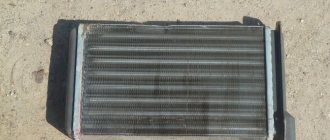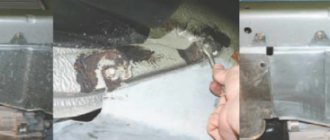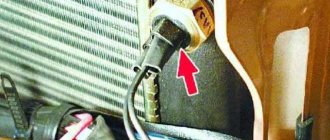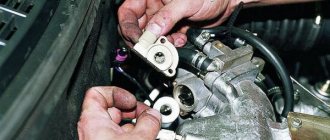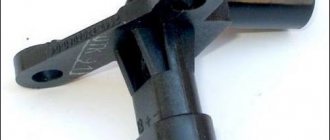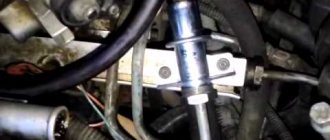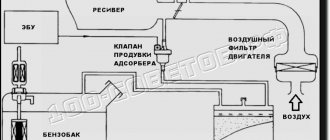The main reason why you have to change the heater motor on a VAZ 2110-2112 is the appearance of a rather unpleasant sound - a squeak, a squeal... call it what you want. In general, when the heater fan on your car starts to squeak, even lubricant in most cases cannot solve this problem. As a result, the only reliable solution is to completely replace the heater motor.
This work is certainly not fast, but in principle, you should not have any special problems when performing it. On VAZ 2110-2112 cars there are two types of interior heater, old and new. So, in this article we will consider an example using an old-style stove, since my car is manufactured in 2002.
- 10mm deep head;
- a Phillips screwdriver, regular and short;
- ratchet with extension.
To get to the heater motor, you will need to perform some preparatory steps, namely:
- Remove the wipers along with their arms.
- Remove the top plastic trim of the windshield (frill).
- Remove the hood seal and the insulation that covers the heater housing.
After this you should see the following picture:
To understand everything, it is better to watch the special video instructions that I will prepare for this article.
Video review of replacing the heater fan (motor) on a VAZ 2110-2112
This process is shown using a dozen examples. If you have any questions after watching the video, write them in the comments either to this article or on my channel.
If we describe this process briefly, the procedure will be as follows:
- Remove the top clips - metal spring clips.
- Unscrew all screws securing the motor housing, side, bottom and middle.
- Unscrew the nut securing the negative wire and disconnect the positive plug.
- Remove the stove body assembly with the fan.
Installation proceeds in reverse order. In principle, in the video guide presented above, this process, both removal and installation, is shown as clearly and accessible as possible. If you have any questions, ask below in the comments.
It is worth mentioning the price of a new heater motor for a VAZ 2110-2112, it ranges from 1000 rubles for a high-quality domestic fan.
Design of the VAZ-2110 heater
The SAUO replaced manual control of the heater, but otherwise the stove remained structurally the same.
As in earlier models, the interior heating system is a housing with a radiator installed inside, connected to the cooling system of the power unit - a heat source, dampers that redirect the air flow to the desired zones, and a fan driven by an electric motor, which creates the air flow. SAUO is a controller that, depending on the set parameters, monitors the temperature in the cabin and regulates the position of the dampers, maintaining the specified mode. The efficiency of the VAZ-2110 interior heater would be low without the forced creation of air flow, and this task falls on the stove fan.
Stove fan
Structurally, the fan consists of a DC electric motor with a commutator-brush assembly and an impeller mounted on the electric rotor. motor. The electric motor is powered from the vehicle’s on-board network. There are several modes of fan operation, the difference between which comes down only to the rotor rotation speed, and this is realized by inserting a resistor into the power supply circuit of the electric motor.
The fan operating mode is set using a handle located in the heater control unit on the center console. Initially, on the VAZ-2110, this handle was part of the design of the SAUO controller, but functioned separately from the controller itself. Later, the ACS added an automatic fan control function (position “A” on the handle), using which the controller regulates the rotation speed of the electric motor in order to maintain the set temperature.
The electric motor used in the design of the VAZ-2110 fan is simple, but it has “weak points” - the commutator-brush assembly and bearings. Wear of these elements causes incorrect operation and complete inoperability of the fan. Short circuits and winding breaks in the stove drive are rare, but don’t forget about these breakdowns either.
Symptoms of failure. Heater components that affect fan operation
Signs of a malfunctioning stove fan are quite obvious and impossible not to notice. Common symptoms of failure:
- Increased noise, grinding noise during operation.
- Significant reduction in air injection efficiency.
- The fan does not turn on.
- Spontaneous change in the rotation speed of the electric motor.
- It can be determined by ear that the electric motor is operating under heavy load.
In some cases, such consequences result from malfunctions in the power supply and fan control circuits, so you should check them first. This applies to:
- fuse (blowout is the cause of complete failure of the electric motor);
- resistor (if it is faulty, some speed modes of the electric motor stop working);
- controller (the knob for switching fan modes is part of its design, so malfunctions of the automatic control system affect the functioning of the electric motor);
- wiring terminals of the power and control circuits (oxidation, damage to wires is one of the reasons for a malfunctioning electric fan).
If diagnostics of these elements shows that they are in good working order, it is necessary to dismantle and repair the fan itself. But it can be diagnosed first.
Fan check
A check is done by directly powering the electric motor from the battery (we lay wires from the battery terminals and connect them to the power terminals of the motor) - operation under load, difficulty in gaining rotation speed, squeals and squeaks indicate wear of the drive components and the need to replace them. But if, even with direct voltage supply, the electric motor does not start, it is most likely that it has burned out or the windings have broken. Such faults are difficult to fix and it is easier to replace the entire unit.
Design features of the stove of the old and new models
The design of the electric motor of the stove on the VAZ-2110 is identical, but the fans and their location are different. On models of the first years of production, the electric fan is installed in the stove housing in front of the radiator and it is located horizontally (old-style stoves). Afterwards, the design was revised - the fan was already placed in the cabin filter housing and installed vertically (new model heaters).
Despite the design features, dismantling the fan is a simple operation and does not require complete disassembly of the stove.
On a VAZ-2110 with an old-style heater, to remove the electric fan you need to:
- Dismantle the frill.
- Remove the front wall of the niche in which the heater is located.
- Remove the back cover of the fan housing by first unscrewing the screws and removing the clamps.
- Disconnect the wiring from the fan and remove it.
As for models with a new type of stove, the technology for removing the electric stove fan on such cars is different:
- dismantle the “jabot” and the front wall;
- remove the air filter;
- unscrew the fastening of the filter housing to the stove body and separate them;
- disconnect the wiring;
- remove the filter housing together with the fan;
- dismantle the electric fan.
After removing the electric motor with the impeller, we disassemble it, perform troubleshooting, replace worn elements and put it back together.
Replacing the stove motor
The main reason why you have to change the heater motor on a VAZ 2110-2112 is the appearance of a rather unpleasant sound - a squeak, a squeal, call it what you want. In general, when the heater fan on your car starts to squeak, even lubricant in most cases cannot solve this problem. As a result, the only reliable solution is to completely replace the heater motor.
This work, of course, is not fast, but in principle, you should not have any special problems when performing it. On VAZ 2110-2112 cars there are two types of interior heater - old and new. So, in this article we will consider an example using an old-style stove, since my car is manufactured in 2002.
Replacing the heater radiator on VAZ 2110 and 2112. When the resource is exhausted
- Old model (until 2003);
- New model (since 2003).
- Remove the rubber seal from the wind lining;
- The fasteners are unscrewed and the frill is removed;
- Remove the windshield trim. To do this, unscrew the nuts and screws located along its edges;
- The hose is removed from the front window washer. It should be moved to the side, otherwise it will interfere with further work;
- Unscrew the wiper fastenings;
- The cover (wind deflector) is finally removed;
- The metal clips are removed from the stove body. They are examined carefully, if corrosion is visible on them, then they need to be replaced with new ones;
- Remove the filter in the cabin, which is attached to the heating radiator with screws; Turn off the fan. To do this, remove the positive connector and unscrew the nut from the negative terminal (on the body);
- Unscrew the 3 screws securing the stove cover;
- Loosen the hose clamps. We remove the radiator.
- The supply hoses are dismantled. Also remove the steam exhaust hose. It is enough to disconnect it from the stove. They are all attached to clamps;
- Chips are removed from the fan;
- The gear motor is disconnected from the power supply;
- Unscrew 3 screws securing the gear motor;
- We find the places where the radiator is attached to the body and unscrew the screws;
- Unscrew the screws from the filter cover. We extract it;
- Unscrew the screws securing the radiator halves;
- Now you can remove the heater itself. We first pull out the left part, then the right;
- Unclamping the brackets, remove the damper.
Preparing for replacement
If you have at least some skills in working with wrenches and screwdrivers, replacing the stove motor will be a feasible repair for you.
To get to the electric motor of the VAZ 2110 heater, you first need to open the hood and remove the “-” battery terminal.
Now, in fact, we are removing the motor itself, which does not work as we need, or has completely failed:
- The windshield wipers need to be removed. To do this, pry off and remove the rubber caps, take a 10mm wrench, unscrew the nuts, disconnect the brushes;
- We pry up the decorative plugs (a slotted screwdriver is useful here), unscrew the screws that secure the frill, then a couple more nuts on the edges (with a 10mm socket wrench), remove the frill;
- Having removed the rubber seal, unscrew the screws with which the engine compartment shield is attached;
- Now, remove the hose that supplies washer fluid to the injectors;
- The most difficult task is getting to the right side of the engine compartment to remove it. It has two nuts at the bottom (also for a 10mm socket wrench). It would seem easy to unscrew, but it’s just painfully inconvenient. Although there is a positive point here - these nuts do not have to be completely unscrewed - the shield can be pulled out after a few turns;
- Before disconnecting this shield, remove the clamps from the hose going to the vacuum brake booster;
- Unscrew the screws (4 pieces) from the cabin filter cover and remove it;
- The heater motor has already appeared. It is necessary to disconnect the heater motor block, as well as the resistor block;
- Now you can pull out the left side of the stove, and with it the fan motor;
- It became possible to replace the heater fan;
- Reassembly is carried out in the same order, only exactly the opposite.
Be prepared for the fact that for the first time replacing the heater motor on a VAZ 2110 (repair) will take you a couple of hours.
Replacement of micromotor gearbox
To replace an element, you will need to perform several not particularly complex activities. Therefore, it is not at all necessary to go to a service station and pay a lot of money for their services.
- First of all, remove the frill.
- Next, the vacuum brake booster is dismantled.
- After this, you still need to remove the pedal assembly.
- Now we begin to dismantle the old micro-gearbox along with the plastic component.
- A new micromotor gearbox should be installed in place of the damper sector. There you will see a similar square.
Article on the topic: How to change the heater tap on a VAZ 2109 yourself
Device location
Practice shows that replacing a micro-gearbox does not require special skills, a lot of time or excessive effort. However, never forget to be careful.
But in order to install the damper of your micro-geared motor, you will need to invite an assistant.
- First, the contacts are connected to the new micro-gearbox, that is, the motor.
- By turning the damper counterclockwise, you turn on the cold air supply.
- Turn on the ignition and turn the heater control system (SAUO) sensor to the position directly opposite the blue dot of the regulator.
- Or you can do the opposite, that is, check the micro-gear motor by installing the sensor opposite the red dot, and turn the damper all the way clockwise.
- The micro-gearbox rotates slightly more than required, so for proper installation it is recommended to use a special lubricant for the square.
- Install the motor so that the holes for the screws match.
- Now you need the help of your friend, since his task will be to turn the temperature regulator and at the same time press the motor inward.
- If the squares match, the replacement of the micromotor reducer can be considered successful. Now the air should flow to the desired temperature inside the cabin.
- Don't worry if the square doesn't go the full length of the flap you're using. This is normal when the gear motor goes about a third of the way. This installation will not affect the performance of the system in any way.
- Now all that remains is to return the screws to their place and twist the micro-gearbox several times - from the blue mark to the red one, and in the reverse order.
- These manipulations will allow the stove to remember what operating range the new gearbox has. Therefore, there will be no problems with its performance in the future.
Possible causes of malfunction
Before carrying out repairs, you should carefully study the possible causes of a malfunction of the car heater fan:
- Burnt fuse. The real reason is the most banal and simple, but at the same time it is the one that leads to the greatest problems in solving the existing issue. Replacing a fuse turns out to be a very simple procedure that any motorist can successfully handle. Despite simple repairs, it is extremely difficult to detect the short circuit that led to the blown fuse.
- Oxidation of contacts that should be used to establish the operation of a car heater.
- The ignition relay does not allow the heater to turn on and start working successfully.
- An additional resistor can result in only the third speed being operational.
- A faulty car interior heating switch requires replacing the fuse.
- A non-working electric fan motor is another important reason. In this case, it is necessary to replace the heater motor or at least check its contact with the vehicle. In most cases, the cause is hidden in a burnt-out electric motor, poor contact with the machine, or sticking electric motor brushes.
Regardless of the cause of the malfunction, you can successfully adjust your car heater
The most important thing is to understand what exactly is the cause of the breakdown or partial disruption of the functionality of the heating equipment
If diagnostics have confirmed that the cause lies in the heater motor, replacing the heater fan most often becomes a mandatory task. How to carry out such a responsible procedure and how easy does it promise to be?
The radiator fan on the VAZ-2114 is used to forcibly cool the engine and cooling system when natural cooling is insufficient. It turns off especially often if the temperature sensor is broken.
Its failure can lead to unexpected consequences, therefore, it is necessary to determine the cause of the malfunction in a timely manner and eliminate it. If the motorist is unable to do this, then it is worth contacting a car service center.
Throw off the » — » battery cable to replace the fan of the VAZ 2110 stove
2. Disconnect the “+” connector of the heater fan wires
3. Using a ten key, unscrew the nut...
4...and remove the negative wire.
5. Use a screwdriver to unfasten the four brackets...
6. carefully bending the lid,
7. Remove the stove fan and replace it with a new one if it is not possible to repair it.
When installing the electric motor, make sure that it does not touch the housing when rotating.
The stove releases cold air
The first thing to do is to determine the cause of the breakdown. This will help you find ways to solve it. But there are quite a lot of them, so let's look at the most popular ones.
One common reason is that only cold air comes out of the unit. This is the first sign that the stove is not working properly. The reason lies in the fact that the interior temperature sensor has broken down - it is responsible for what conditions are in the cabin and whether they correspond to those set by the driver. If it fails, then its readings are incorrect. Thus, the stove receives information that it is hot in the cabin. It will therefore produce cold air to make conditions more comfortable.
It's easy to fix this problem. There are several steps you need to take. First, remove the lampshade by unscrewing it. Then install a new sensor and check it for serviceability.
In this case, care must be taken not to reverse the polarity. Otherwise, the device will not work properly.
Also, the reason that cold air comes out of the stove can be a breakdown of the gear motor. To determine it, you must first check the temperature sensor for serviceability. If everything is in order with the latter, then clearly the problem lies in the gearmotor. It is worth noting that this part, like the previous one, cannot be repaired. The only way to solve the problem is to replace it with a new one.
This process is a little more complicated. It consists in carrying out the following actions. First, the wipers are removed. Then you need to unscrew the bolts that are responsible for fastening the frill and remove it so that it does not interfere. Thus, access to the element that has failed will be obtained.
Then you need to remove the gearmotor itself. To do this, its fastening is unscrewed. A Phillips screwdriver will help with this. Next, you should carefully disconnect all the wires. This should be done as carefully as possible so as not to damage anything. This is the only way you can completely dismantle the broken part. Using the same principle, but in reverse, install a new element. At the same time, make sure that the cut of the part clearly fits into the damper.
How to replace the heater fan on a VAZ 2110-VAZ 2112
These instructions for replacing the heater motor are suitable for many cars of the tenth family, but not for all, because dozens were produced in very different configurations and designs over the entire time, some VAZ 2110 even had an engine from Opel installed from the factory, such a car is marked VAZ 21106, therefore, we won’t be able to write about everything (since it will be a very long article), we’ll just take the most common tenth family and use its example to show how to replace a stove motor through descriptions and pictures!
First of all, you will need to get to the motor, it is hidden under a trim that is located under the windshield, and inside this trim, the motor is still placed in a casing, so you will have to remove a lot of decorative elements, in more detail how to do this is described in the article entitled: “Replacing the cabin filter on a VAZ 2110” and by the way, the trim that is located under the windshield cannot be removed without removing the brush, and when you lift it, pay attention there will be a tee under it (see the large photo for the location where it is located) , disconnect the hose from it that is connected at the bottom (see small photo) and the trim can then be removed from the car
2. We go further, as soon as all the elements that prevent access to the casing in which the motor is located are removed, find the wires coming from the motor, or to be more precise, one Plus wire and one Minus wire, so the minus (Indicated by a green arrow) is attached to nut (Indicated by a blue arrow), you unscrew it, but the plus (Indicated by a yellow arrow) is connected to the other wire through a wire block and a connector (see small photo), disconnect them from each other.
Replacing the heater motor Lada 2111 (VAZ 2111)
Installing a Grant thermostat in a VAZ 2110 to increase the efficiency of the stove
The next stage of preparation for winter was the replacement of the VAZ 2110 thermostat with a thermostat from Granta. First of all, the question is why? The whole trick of the 2190 thermostat is that it is able to completely cover the “large circle”; therefore, the coolant warms up much faster (and is much warmer in winter). The temperature of the internal combustion engine with it is much more stable and stays around 85-90 degrees.
It turns out that: 1. With a thermostat from Granta, the cabin is warmer, because the stove is connected in series, and not in parallel, as is the case with a five or six-hole dermostat 2. The performance of the stove does not depend on the pump speed 3. We do not heat antifreeze in the expansion tank (connected through a tee together with the stove outlet to the return pipe) 4. We do not heat the antifreeze in the radiator (the upper radiator hose is blocked, everything that goes to the radiator comes from the return pipe through the lower hose)
We have: 1. Significantly faster warm-up, especially while driving 2. Warmth in the cabin 3. More stable temperature conditions - traffic jams, use of the stove, cold air flow 4. Fast switching to gas - heating of the gas reducer in the circuit occurs immediately after the engine, Heating of the gearbox and the stove are connected in series
Is this necessary? I think so. And if yes, then we do it.
What we need: 1. Thermostat 2190 BEHR (article 21900-1306010-00) - 600 rubles. 2. Thermostat gasket - 10 rubles. 3. M8 80mm stud (classic r/v bodies, Niva), 2 pcs. — 24 rub. 4. Washer M8*20*2 mm flat (for the wing screw), 4 pcs. — 20 rub. 5. Coolant temperature indicator sensor TM 106 old model - 90 rubles. (Must be of the OLD SAMPLE!) 6. Tee of the cooling system (old sample) VAZ 2110 - 30 rubles. 7. Lower radiator pipe 2190 — 550 rub. 8. Adapter for stove GAZ-3302 (plastic 20 mm) - 30 rubles. 9. Heater adapter angular 20 mm (metal) - 50 rub. 10. The antifreeze is the same as what you filled in. Liters 6... 11. Gray ABRO sealant and clamps. Decide for yourself what size you will need and buy with a reserve.
Let us separately focus on the lower radiator pipe 2190.
For information: Grant pipes are sold ONLY in pairs and are expensive. At the car market, original pipes cost 2000 rubles! Set. I couldn’t find it separately, no matter where I looked. And in general, at the moment, Grant pipes are very rare for sale. Thank God, the BBC received analogues for 500 rubles. per set. And this is compared to other prices - the price is fabulous. Therefore, we take it without hesitation. You won't find it cheaper.
They look like this:
Now everything seems to be bought. And you can start working - but DO NOT Rush! I hurried, did not fully study the question, and it turned out to be in vain. I would like to draw attention to a point that you may have ALREADY not paid attention to. Specifically, I quote - “The temperature of the internal combustion engine with it is much more stable and stays around 85-90 degrees.” In reality, on my engine in motion it stays somewhere around 82-83 degrees, which is 10 degrees below normal. No, the stove heats well, it’s hot in the car. However, theoretically this is not good for the engine, and the computer tries to compensate for the lack of temperature by increasing fuel consumption. Yes, slightly - but it will increase by half a liter somewhere. Which exit? The solution is to improve the thermostat.
So, if the thermostat has been modified, or you have decided not to modify it, then you can begin work.
Action plan. 1. The lower radiator pipe is replaced with a Grantovsky one and connected to supply pipe No. 26. Please note that on the standard trumpet there are tens, (saxophone, there is a terminal for heating the “throttle valve”, in the grant it was removed, so we simply dampen this terminal with something - in the photo I can see how I removed the heating of the throttle earlier, simply by connecting thermostat with a saxophone with a small pipe. In the new thermostat there will be no outlet for heating the damper, but in the saxophone it will remain. It needs to be muffled.). 2. The expansion tank pipe must be inserted into the supply pipe through a tee from 2110 C/O, one end of which goes to the supply pipe, the other to the drain from the heater radiator. 3. The standard expansion tank pipe is not enough, so we replace it with the heater pipe 2110 N/O (it is longer). 4. Replace the thermostat studs with longer ones, replace the thermostat and twist the temperature sensor. Drain the liquid. I captured the engine compartment with the old Luzar thermostat.
We try on the “Grant’s lower pipe” - as we see, it fits perfectly.
Then we unscrew everything that bothers us.
That's how much rust was in the tank after draining the fluid. Washed it...
Remove the thermostat. Drain the coolant.
Twist the studs
screw the thermostat with the coolant temperature sensor screwed onto the sealant.
Next, we install the lower pipe, turn off the output for heating the damper; it will no longer be useful to us. There is no such concept in the grant. We put the upper radiator pipe onto the thermostat outlet.
As you can see, due to the fact that I bought a new type of coolant temperature sensor, I was barely able to put the pipe on the thermostat and tighten it with a clamp. Because the sensor is located directly under the clamp, and the old sensor is thinner and there is more space with it.
At the other end of the thermostat we put the coolant supply pipe to the heater radiator. Then we cut the pipe coming from the heater radiator drain and insert a tee into the cut, connect the expansion tank pipe to it. We connect the lower radiator pipe to the supply pipe. Fill with coolant. Let's check.
I want to say the result is excellent. My only regret is that I saw the post about modifying the thermostat too late. With a modified thermostat, there will be fire in the cabin.
Modification of the VAZ 2110 stove
The stove has finished me off, it barely blows into my legs and it’s somewhere in the wrong direction. I tried removing the grilles from the sides, it got better, but still not the same. While I was doing the warming up, I decided to do the “Christmas tree”. Since there was no desire to remove the panel, the “herringbone” had to be removed somehow without removing the panel. I removed the floor tunnel and tried to saw it off with a hacksaw, struggled for about 15 minutes and decided to break it piece by piece with pliers, and after another 15 minutes I succeeded. Now I had to somehow pull it out... I needed to remove all the staples, separate them and take them out. Somehow I removed the staples (by touch) and pulled out this crap. I took it into the warmth and started creating :) I sawed off the lower part, but decided to leave one ear of the fastening so that it would be more securely attached. I inserted the corrugations, attached them with self-tapping screws, filled them with foam, and left them to dry until the morning.
In the morning I trimmed off the excess foam and took it to install.
Corrugations took 40 mm. My octopus got back in without any problems. In the lower part of the tunnel, I cut off several partitions and installed corrugations so that they would not interfere with anything, and in the upper part of the tunnel, I slightly sawed off the holes on the sides for the corrugations, which (like the fins used to be) also went under the seats.
In front of the passenger, I secured the corrugation in such a way that it would blow from top to bottom on both legs (from under the glove compartment in the center down).
At first I did it higher than the previous grilles so that it would blow on the pedals, but I didn’t like it that way, the top part of the boot gets hot, but the sole is cold, so the heat doesn’t heat up much. I decided to redo it and did it behind the pedals (it’s good that I didn’t have time to cut the corrugation yet), the air blows on the throttle and tangentially on the second leg
I haven’t fixed anything thoroughly yet, everything is in test mode, but I’m very pleased with the result, my feet are very warm, due to the fact that the soles are heating up, now I’m waiting for good frosts (so far I’ve tested the current at -16). The rear passengers also get an awesome breeze through the corrugations, in short, everyone is happy. Also, having removed the central nozzles, I bent the rod, otherwise the dampers did not completely close in the “feet” position, now everything is OK.
Installation of additional air supply to the legs with a VAZ 2110 stove
Modernization of the VAZ 2110 heater. Redesign of the air supply to the legs
Siberian weather is characterized by a rather harsh climate, which makes your feet freeze in winter. The first stage was the installation of an additional pump to supply antifreeze to the heater furnace. Everything seems to be healthy, the air has become significantly bitter, but this air does not reach the recipient - that is, to my feet. The air supply system on the top ten is designed in such a way that air is lost in this labyrinth. After reading articles on this subject, it was decided to transfer the air supply and replace the bulky Christmas tree with a corrugated hose. At first, I decided to save money and bought a regular corrugation with a diameter of 40 mm, then, thinking that I would change the awl for soap, I bought a more expensive corrugation with a smooth inner part to reduce air resistance in it. To begin with, it was necessary to dismantle the herringbone, basically in all sources, to achieve this, I completely remove the front panel with all the consequences, I was too lazy to remove the panel completely, so I removed the mafon, sao, on-board computer and buttons, having also removed part of the tunnel, I proceeded to sawing the bottom of the Christmas tree, having sawed off its bottom, I simply lowered it down and took it out without dismantling the panel. I sawed with a regular wood hacksaw.
The bottom cut of the Christmas tree to get it to the top for the result.
Having sawed the tree, I cut out all the excess inside, inserted the hoses and foamed them. The total length of the hose was purchased 2.5 meters, but quite a lot was cut off from all the hoses, so 2 meters is enough.
Then, while the foam was drying, I decided to work on the tunnel and fasteners for the corrugation; to do this, I dismantled the remaining lower part of it. It was decided to supply air to the feet of the rear passengers using a deflector from 2105. For the front passengers, the first thing that caught my eye was two cans of toner from a Samsung 4200
I made the markings and started drilling.
After trying on all this disgrace, I found out that the deflector prevents the lift glass block from sliding into place.
I had to saw it off
little more needed
it turned out like this
took care of the driver's side
\
The first option turned out to be a failure, because after trying it on, it turned out that the hose rested on the computer and did not allow the lid to fit tightly. I had to do the same thing, only with the bottle on its side so that nothing would interfere.
To make the corrugation fit more tightly onto the jar, I used electrical tape and wrapped it around the neck a couple of times.
As a decoration, I used a grid for attaching rivets and a rivet gun, I repeated the same thing on the passenger side, only I moved the hole a little closer to the panel
Final version
Overall, I'm happy with the result, we're looking forward to winter.
Corrugation 2.5*160=400r pack of ties 82r construction foam 145r deflector 2105 85r toner 2*0=0r rivets 16*0=0r decorative grille two pieces*0=0
Replacing the VAZ 2110 stove motor
At lunchtime I was going to go home, got into the car, warmed up the engine as usual, turned the heater motor speed switch to position A, it worked for a couple of seconds and there was silence, the heater stopped blowing, I turned the switch back and forth - no effect. So I drove off in the cold, postponing finding out the reason for later. When I returned from lunch, stopping in the parking lot, I decided to start with the fuse block and this is what I saw there: Fuse F18, which also goes to the stove, melted itself and melted the mounting block, but the contact itself did not break, although it should have been the other way around, on then it is the fuse) (be careful when choosing these)
Chinese fuse
Melted block
It could be anything. It is only clear that there is a short circuit somewhere. I installed a new fuse, but the stove did not work. I postponed the analysis for the evening, until the evening I drove several times on business, nothing, and you get used to driving in a cold car, even without gloves, although the temperature outside is below -10. In the evening in the garage I pulled out the heater control unit, checked the heater motor directly through the block using two wires, shorting the wires, of course it sparked, the glass fuse in the cigarette lighter splitters blew out, but everything was immediately clear. The problem is in the motor. The rest of the time for 4 evenings after work was spent under the hood until midnight. I repeated in practice what it’s like to travel by public transport to work). Nothing, by the way, is tolerable) It would seem that there is nothing difficult in replacing the motor, why is it taking so long! But I repair myself, my own device, and conscientiously, along the way, something in an area where it’s not so easy to get to by improving it. And there really was something to do there. Wipers and frill to the side and here is the top of the stove motor.
Without frill
The location of the motor and the configuration of the stove body are non-standard; I could not find the same one on the Internet. I didn’t remove the “cup” spacer, although it often got in the way; with it, the body cannot be completely removed. The motor is held on by 3 bolts, unscrewing which took most of my time: the bolts are sealed into the stove body from the inside. When I unscrewed the nuts, the bolt heads broke off halfway and began to spin. I quickly unscrewed one bolt, the outer one, removed the front part of the housing and secured it with a key.
Socket of the 1st bolt. There is no filter, that's why it's so dirty
The head of the second bolt is further away, but you can feel the head, even though it is flush with the body. The 3rd bolt is the farthest, you can only get to it by removing the motor, and the motor can only be removed by unscrewing the bolt, that’s the dilemma. Anyway, I tried to solve this problem, but it’s complicated, I thought about cutting out or tearing out the motor, but there’s nothing special to cut out with, it’s inconvenient and a pity, let alone breaking it out. On the second day of torment, an idea came up that at first seemed crazy, but it couldn’t have been better: grind off the nut with a file.
2nd bolt
1.5 hours with a file in an awkward position and the remaining half of the nut was easily twisted.
Cheap and cheerful
The next day I ground off the last nut in the same way and the motor was removed. When rotating, there was a clear sense of imbalance.
Old
In the meantime, I got busy with the wiring and began to restore the wire to the phase sensor that someone had cut off and replaced this sensor, but more on that later
Unused wiring
The worn and rotating heater motor mounting bolts needed to be replaced. 2 bolts came out neatly and I simply glued 2 new ones into their sockets, filling the sockets with 2-component epoxy glue, and the 3rd one was broken off with a piece of the body, and a new one was glued in its place on a piece of plastic.
The length of this bolt was not enough, so then I used a longer bolt
After installing the new mount, I wiped the entire inside of the stove. There is a lot of dirt and it all flies into the cabin, so naturally I wanted to install a filter, but since it is not provided for by the design, I had to come up with something again. I decided to somehow adapt a filter from Priora with a Panasonic air conditioner. The option is to place it only under the round hole from where the motor draws in air. The filter lay neatly under this hole, but did not press, you need to somehow lift it and press it to the body
Filter
I twisted something like clamps with hooks out of aluminum cork, clamped the bend of the filter in 3 places and hung it on the hooks to the body, and then glued the hooks. It looked good and reliable.
Fastening
After that, I installed the new motor without any problems, turned on the heater, and turned it as it should! Fortunately, the mounting block inside was not damaged, which is good. You can put it back together. When reconnecting the parts of the stove, it turned out that one part fit in and the filter was in the way, after several attempts to push the stove back, the filter moved down, a gap formed and, in general, the idea was not entirely successful, the place was also not convenient, after putting the housing back to the filter it was no longer get close, he remained lying there, so there would be little effect (and that’s what I wanted). After that, I applied silicone sealant in places to seal the cracks tightly, sealed the identified hole with noise and then closed the stove completely and put everything back together. By the end of the repair, I had a new heater motor installed and the car was warm, the phase sensor was restored, I still don’t understand the difference, and several wires were found that I still don’t understand where they should go, but I have guesses: an oil level sensor and a 2nd position sensor crankshaft also without wiring. We need to restore...
Dismantling the VAZ 2110 heater
Let's dismantle the heater and see what's so rusty on the wheel arch that was revealed on the last one.
Gentlemen of Volgovoda, you say that you are complaining that on the Volga it is inconvenient to remove the stove, you have to remove the panel there, well, look at the creativity of AvtoVAZ
Down with the frill
Down with the expansion tank and windshield wiper trapezoid. The axles are loose in the bushings.
a little more freely
The car is on its side for convenience. Where did the force go, I could hardly hold it, I would have inserted a cotter pin into the tilter, the machine almost lay down on its belly.
Down with the corrugated air filter. Do you want to laugh? Where did you install a throttle valve with a larger diameter? Did you feel it? Is it okay that the air supply hole to the filter is even smaller than a standard throttle valve? On 2111 there was a plastic pipe of larger diameter, and here is such a miracle
I unscrew the lower heater mount, also known as the sound insulation mount.
You can take it off soon!
fastening at the arch and on top...
Do you think you can take it off now? Whatever the case! Now you need to either “split” the heater into 2 parts and pull it out piece by piece, or remove the brake pedal with a vacuum (I don’t care to remove it, it’s too flimsy at the factory, but you can just move it to the side on the tubes, if the tubes allow it.
Now you can unscrew the hoses and remove the entire heater
Looks like it's already been filmed.
Because the radiator is marked. From disassembly?
Behind the heater is a piece of Shumka, less than 10 percent of which is glued, the rest is just lying there and there are large technological plugs
I cut off the sealant and tap the seam. Here it is, another place for future welding.
The place is always damp, when replacing the heater radiator, I advise you to inspect it so that something like this doesn’t happen...
https://www.drive2.ru/l/4877822/, https://www.drive2.ru/l/2889510/, https://www.drive2.ru/l/4899916394579123633/, https://www .drive2.ru/l/1844519/, https://www.drive2.ru/l/5084681/, https://www.drive.net/l/5565591/
Source
- https://spike.su/index.php/Repair-stove-VAZ-2110.html
Work to replace the fan in the cabin
Replacing the heater motor of a VAZ 2110
The subsequent change of the heater motor will be done directly from inside the car:
Under the dashboard you need to find the block that goes to the electric motor. She disconnects. After this, you will need to unfasten the ground wiring of the electric motor. As a rule, it is pressed to the body by the front mounting nut of the heater. The trim and lining of the windshield frame are dismantled, and you cannot do without unscrewing the mounting screws. The right upholstery is removed from the interior heater, and the fastening nuts and screws should also be unscrewed. Heating hoses are disconnected
At this stage of work, extreme caution must be taken, since antifreeze residues may leak from these hoses and the heater radiator. To prevent the smell of coolant in the car interior, you need to lay a material that absorbs moisture well. The wiring is disconnected from the electric motor, from the micro-reducer, and also from the pneumatic valve. After these steps, remove the front housing with the stove casing. These elements are fixed with brackets and screws. It is worth noting that the engine and motor are located on the casing. The latches are removed, and the engine and motor are removed.
Recommendations for replacing the motor
Replacing the heater motor of a VAZ 2110
You can disassemble the electric motor yourself only to evaluate the collector and clean it. If the cause of the breakdown lies in another situation, then it is not advisable for a non-specialist in working with such parts to disassemble it. It is better to buy a new electric motor.
Note! It is also not recommended to dismantle the engine impeller on your own, since when it is installed in its place, the balancing, which plays an important role, will be disrupted. Naturally, the electric motor will function, but not smoothly, which can lead to breakage of the bearings and noise when the stove is turned on.
Since the stove is in a disassembled state, it becomes possible to calmly view the other components of the cabin heater. So:
- In order for more heat to come from the radiator, you need to dismantle it and wash it. It is fixed on the rear casing of the heater, which is removed by unscrewing the mounting screws. After this, the radiator can be easily removed and washed under the pressure of water flowing from a hose that is connected to the radiator inlet or outlet tube. The same pressure washes away dirt from the surfaces of the removed radiator.
- To disassemble the air ducts and heater control mechanisms, you will need to remove the instrument panel on which the main air ducts are located.
Note! Usually the panel with the main air ducts is made as one piece, so it must be handled with the utmost care so that it does not have to be replaced later. After this, you need to remove the interior air ducts, which are secured with special screws, and the decorative lining of the floor tunnel
After this, you need to remove the interior air ducts, which are secured with special screws, and the decorative lining of the floor tunnel.
Note! Under this trim there are air ducts for heating the feet, which are attached to the body with screws and latches.
- The air distributor is removed from the dashboard by unscrewing the mounting screws and disconnecting the damper control rod.
- Reassembly must be done in the reverse order of disassembly. If necessary, fix the damper seals with glue. You can also seal the attachment points of the hoses with the radiator with sealant.
- When all the parts are assembled and installed in their places, the functioning of all components is checked and antifreeze or antifreeze is added. It all depends on personal preference.
- At the final stage, they check the tightness of the attachment of the hoses to the radiator and the actual operation of the assembled stove.
For those who perceive information visually, it is recommended to watch a video with a detailed description of the actions and several photos that will help you do everything correctly.
Repair work can be carried out with your own hands, but subject to clear instructions. This will help you save a lot of money, because the price for services of this kind in car services is not cheap.
Diagnostics, repair and replacement
You can check the gearmotor immediately after dismantling. You need to apply 12 volts to the contacts of the power connector. The easiest way is to take this voltage from the battery. We put two wires on the battery and connect them to the connector contacts. The gearmotor shaft should begin to rotate. When the polarity changes, the shaft movement must be reversed.
If this does not happen, disassemble the gear motor. If the servo drive operates, then the problem is in the control unit or wiring.
You can only disassemble the micromotor gearbox of a new type on your own. The plastic case is held on by clamps and can be easily separated into two halves with little effort.
After disassembly, we try to rotate the worm of the electric motor shaft with our fingers. If it rotates easily, then the mechanical part is working properly. Inspect the gear teeth. The recesses in the top cover for the gear shafts must be intact, without chips or ellipsoidal wear.
We try to apply voltage to the motor directly, past the chip. In some cases, a break is observed precisely in this area. If even after applying voltage directly nothing happens, the repair of the gear motor of the VAZ-2110 stove can be stopped at this point. The motor is faulty. It will be necessary to install a new motor or completely replace the gear motor, which is usually done due to the lack of suitable electric motors on sale.
Video: The stove on the VAZ 2110 does not heat up? Replacing the heater damper gearmotor
Replacing the gear motor of the VAZ 2110 stove of the new model, like the old one, is carried out in the reverse order of dismantling.
The only recommendation at the installation stage is to check the functionality of the new part. There are cases where even new spare parts had defects. And if you purchased a used servo drive, checking is required.
The test scheme is the same as at the diagnostic stage: we simply apply voltage to the windings of the gearmotor and change the polarity. The motor spins, the rod turns - we install the gear motor in its place.
Causes of malfunction
There can be many nuances that the heater motor has begun to work poorly. Among them are two main ones that can be helped by a small repair rather than a complete replacement of the fan. The commutator brushes may well wear out. The brushes themselves, in turn, can “gnaw through” the copper lamellas of the collector, which is why it does not want to work, and the heater motor “goes silent.”
Although this happens quite rarely, brass sleeves of plain bearings can squeak or whistle. Repairs are made by regular lubrication, although this usually helps for a short time; sooner or later the electric motor will need to be replaced. So, if you still have to get to the furnace fan, perhaps replacing it completely will be the best solution. In addition, it saves your time.
Adjusting the automatic control system
To check the functionality of the device, you should take a mercury thermometer and place it near the temperature sensor. After this, you need to activate the stove controller and set the fan control knob to position “A”. The automatic control system should be carefully adjusted only if after 15–20 minutes the temperature is more than two degrees below the data from the sensor.
In order for the self-propelled gun to work better, you will have to pull it out and then turn the knob located on the left side of the controller several times. You can increase the temperature by turning the knob clockwise, and decrease it by turning it counterclockwise.
How to prepare for the event
If you need to repair a VAZ stove fan, you need to make sure you have the necessary tools:
- head 10 millimeters, deep;
- Phillips screwdriver (2 varieties: regular and short);
- ratchet with extension.
Only if all the tools are available can the main activities be carried out. Of course, for a successful result, at least minimal experience with wrenches and screwdrivers is required. If there is no relevant experience, the task at hand becomes significantly more difficult.
Causes of malfunction
As a rule, there are many reasons for such a malfunction, these include:
- clogging with slags from;
- stove motor failure.
If the stove motor is not functioning, or some of its speeds are not working properly, then it is first recommended to check the resistor, which in other words can be called the stove rheostat. This element is responsible for the speed of the fan. You can purchase such a part in a specialized store that sells auto parts. As for replacement, this can be done with the help of a specialist or on your own, which is not so difficult even for an inexperienced specialist.
There are heater malfunctions that can be easily fixed by any car enthusiast. For example, a situation may occur when cold air blows through the side deflectors and the windshield heating duct of the heating system, while a hot air flow comes from the lower and central air ducts. Most likely, the reason will be unsatisfactory performance, which is designed to cut off cold air. In some cases, it prevents the normal passage of cold air. Such faults are most easily identified during the cold season.
When bending the damper drive rod, special care must be taken so as not to damage the plastic parts. Please note that plastic becomes more brittle in winter.
Of course, a non-functioning stove causes many problems in winter.
If this is not so important in the summer, then in the winter the windows will fog up. You can figure out what the reason is by disassembling the heating system of the car.
